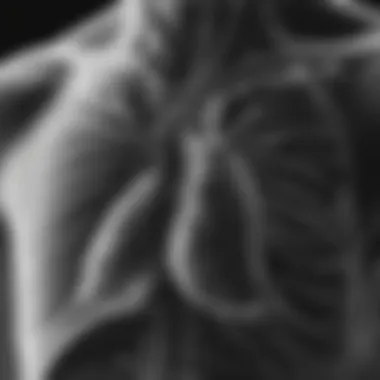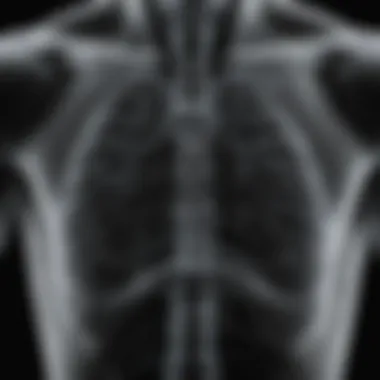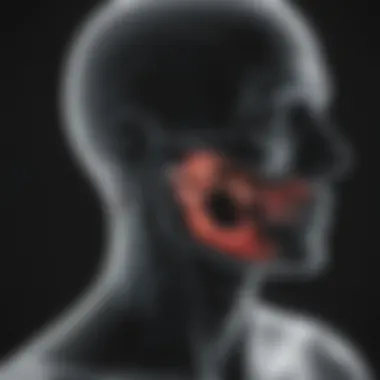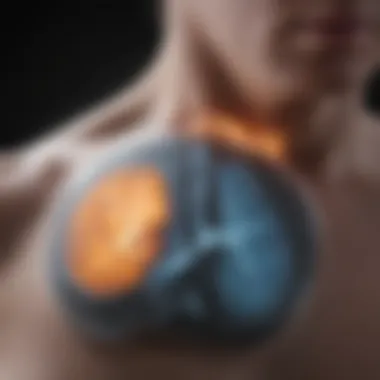Exploring Lung Cancer Diagnosis with X-Ray Imaging


Intro
Lung cancer remains one of the most pressing health issues worldwide, demanding advanced diagnostic methods for effective management. The complexity of this disease necessitates a multifaceted approach, particularly as it often presents at advanced stages. X-ray imaging plays a crucial role in the initial detection and ongoing assessment of lung cancer. This article explores intricate details of how X-rays aid in unveiling this disease, emphasizing their methodologies, significance, and recent advancements.
Research Overview
Methodological Approaches
X-ray imaging has evolved within a rigorous framework of methodological approaches. Two primary types of X-ray techniques used in lung cancer diagnosis are chest X-rays and computed tomography (CT) scans. Chest X-rays are often the first imaging technique employed when lung cancer is suspected. They provide a quick overview of the lungs and can reveal abnormal masses or nodules. Meanwhile, CT scans offer a more detailed, cross-sectional view of the lungs, enabling better characterization of lesions or tumors.
Some important aspects of these methodologies include:
- Image Quality: Higher resolution images improve the accuracy of diagnosis.
- Radiation Exposure: Finding a balance between image quality and patient safety is essential.
- Interpretation Skills: Radiologists must be adept at distinguishing benign from malignant lesions, which requires extensive training and experience.
Significance and Implications
The significance of using X-rays in lung cancer diagnosis cannot be understated. Early detection through X-ray imaging contributes to better treatment outcomes and potentially improves survival rates. For instance, when lung cancer is identified at an earlier stage, patients often have more treatment options available, ranging from surgery to targeted therapies.
Moreover, the implications extend beyond individual patients. Public health initiatives aiming to increase awareness and early diagnosis rely heavily on the effectiveness of X-ray technology.
"The ability to detect lung cancer early is crucial in improving patient outcomes and survival rates."
Current Trends in Science
Innovative Techniques and Tools
Advancements in imaging technology continually reshape the landscape of lung cancer diagnosis. One such development is the introduction of digital X-ray systems, which enhance image readability and reduce radiation exposure. Furthermore, artificial intelligence (AI) applications in radiology have started to aid in identifying potentially malignant lesions with greater precision than before.
AI tools can analyze vast datasets of historical imaging cases, allowing for more accurate interpretations that help in decision making. These innovations promise to enhance diagnostic accuracy and ultimately improve patient care.
Interdisciplinary Connections
The nexus between X-ray diagnostics and other fields is increasingly evident. Collaboration between radiologists, oncologists, and information technologists fosters a more comprehensive understanding of lung cancer. In addition, educational institutions are beginning to integrate these interdisciplinary approaches into their curriculum to prepare the next generation of healthcare professionals.
In summary, this article delves deep into the role of X-ray imaging in understanding lung cancer by exploring its methodologies, significance, innovative tools, and broader connections in the medical field. Through a focused lens on advancements and implications, it aims to equip students, researchers, educators, and professionals with valuable insights into this critical area of healthcare.
Intro to Lung Cancer
Lung cancer represents a significant global health challenge, being one of the most prevalent forms of cancer. Understanding lung cancer through accurate diagnostic tools is crucial for timely intervention. X-ray diagnostics plays a key role in this sphere, facilitating early detection and assisting healthcare professionals in determining appropriate treatment pathways. This section delves into the complexities of lung cancer, highlighting its nature, characteristics, and relevance in the context of diagnostic imaging.
Overview of Lung Cancer
Lung cancer is primarily categorized into two main types: non-small cell lung cancer and small cell lung cancer. The former accounts for approximately 85% of cases, while the latter is less common yet more aggressive. Symptoms often include persistent coughing, chest pain, and difficulty breathing.
Diagnosis typically involves a combination of patient history, clinical examination, imaging studies, and laboratory tests. X-ray diagnostics are often the first-line imaging modality due to their accessibility and speed.
These diagnostics help in identifying abnormal masses or lesions within lung tissue, offering initial insights into the presence of cancer.
Epidemiology and Statistics
The epidemiology of lung cancer underscores the importance of understanding risk factors and identifying affected populations. According to the World Health Organization, lung cancer accounts for nearly 2 million deaths annually, making it a leading cause of cancer-related mortality worldwide.
Key points on lung cancer epidemiology include:
- Risk Factors: Smoking is the predominant risk factor, responsible for a majority of lung cancer cases. However, exposure to radon gas, secondhand smoke, and occupational hazards also contribute significantly.
- Age: Lung cancer is more prevalent in older adults, particularly those above the age of 65.
- Gender Disparities: Men are historically more likely to develop lung cancer, though the incidence in women has been increasing.


Statistics illustrate that early diagnosis significantly improves prognosis. Early-stage lung cancer has a much higher survival rate compared to late-stage presentations, emphasizing the need for robust diagnostic practices such as X-rays.
Role of Imaging in Lung Cancer
Imaging plays a critical role in the diagnosis and management of lung cancer. Various imaging techniques, especially X-rays, provide invaluable insights that assist healthcare professionals in detecting lung cancer at an early stage. Early detection often correlates with improved treatment outcomes and higher survival rates. Thus, the importance of timely imaging cannot be understated.
This section will explore two key facets: the importance of early detection and the role of X-ray as a diagnostic tool.
Importance of Early Detection
Early detection of lung cancer is essential for better prognosis and treatment success. Symptoms often do not appear until the disease has progressed, which makes timely imaging crucial. Regular chest X-rays or screenings are recommended for high-risk populations. The challenge lies in ensuring that people at risk are adequately monitored.
Benefits of early detection include:
- Increased Treatment Options: Identifying lung cancer in its early stages opens up a range of treatment options, from surgery to chemotherapy.
- Improved Survival Rates: Statistics show that the earlier cancer is detected, the higher the chances of successful treatment.
- Reduction in Healthcare Costs: Treating early-stage cancer can be less expensive compared to advanced stages requiring more extensive interventions.
"Timely imaging and early diagnosis remain pivotal in combating lung cancer".
X-ray as a Diagnostic Tool
X-ray imaging serves as a frontline diagnostic tool for lung cancer. It is often the first step in detecting abnormalities within the lungs. Chest X-rays are widely available, cost-effective, and quick, making them ideal for initial evaluations. Although they may not always determine the precise nature of a lung abnormality, they can reveal signs that warrant further investigation.
The use of X-rays in lung cancer diagnostics includes:
- Identification of Lung Nodules: X-rays can help detect small nodules that may indicate cancer. Any suspicious shadow needs to be followed up with additional imaging or biopsy.
- Monitoring Progression: For diagnosed patients, X-rays can track changes in tumor size and response to treatment.
- Guiding Further Diagnostics: When X-rays show abnormal results, they often lead to more detailed imaging options such as CT or PET scans.
Types of X-Ray Techniques
Understanding the various types of X-ray techniques is essential for effective lung cancer diagnostics. Different imaging modalities offer unique benefits, limitations, and protocols that can significantly influence patient outcomes. The comparative analysis of these techniques enriches our comprehension of how lungs can be examined with precision, aiding healthcare professionals in making informed clinical decisions.
Chest X-Ray
A chest X-ray is often the first imaging test conducted when lung cancer is suspected. It provides a quick overview of the lung structure and can reveal presence of abnormal masses or lesions. While chest X-rays are relatively low in cost and require minimal radiation exposure, they carry limitations. They may not detect small tumors or early-stage lung cancer that can be crucial for appropriate intervention. Therefore, interpreting a chest X-ray involves understanding its constraints.
Key points about chest X-rays include:
- Common Applications: Used to check abnormalities in lungs, heart size, and structures in the chest.
- Radiation Exposure: The level is typically low, making it generally safe for most patients.
- Limitations: Possibility of false negatives; smaller or early lesions may go undetected.
Computed Tomography (CT) Scans
Computed Tomography scans offer a more detailed view than traditional chest X-rays. CT scans utilize multiple X-ray images processed through a computer to create cross-sectional views of the lungs. This method greatly enhances sensitivity and can detect smaller tumors that may escape detection on standard X-rays. While CT scans involve higher radiation exposure, the trade-off comes in the form of detailed imaging that allows for better diagnostic accuracy. Benefits and considerations of CT scans include:
- Higher Sensitivity: Can identify smaller lesions, aiding in early diagnosis.
- Detailed Imaging: Produces slices of images that help in understanding the extent of cancer.
- Radiation Dose: Increased exposure compared to standard X-rays, which needs to be justified.
Positron Emission Tomography (PET) Scans
PET scans are an advanced imaging modality that assess both the structure and function of the lungs. By using a radioactive tracer, PET scans can reveal metabolic activity of tissues. This capability is crucial for determining the aggressiveness of lung tumors and for evaluating spread to lymph nodes or distant organs. PET scans are generally combined with CT scans for comprehensive assessment. Key attributes of PET scans are:
- Functional Imaging: Visualizes metabolic activity, helping differentiate between benign and malignant lesions.
- Staging and Monitoring: Critical for assessing the extent of disease and response to treatment.
- Limitations: Higher costs and typically more involved procedures compared to standard imaging modalities.
Interpreting X-Ray Findings
Interpreting X-ray findings is a critical aspect in the diagnosis and management of lung cancer. This process involves analyzing the images obtained from X-ray techniques to identify abnormalities that could indicate the presence of lung cancer or other pulmonary diseases. The importance of accurate interpretation cannot be overstated. It directly influences patient outcomes, as early and correct identification can lead to timely interventions and significantly better prognosis. Radiologists and clinicians must be trained to recognize more than just the visible structures; they must understand the subtle cues that could signify malignancy.
In clinical settings, findings from X-rays can guide further testing and influence treatment strategies. Misinterpretation of these images could result in delays in appropriate care or misdirection in treatment plans. Thus, clinicians must maintain a keen awareness of the common signs of lung cancer, while also being prepared to differentiate these from conditions with similar presentations.
Common Indicators of Lung Cancer
When interpreting X-ray images, several indicators may suggest lung cancer. Some of the most common indicators include:


- Masses or Nodules: These could appear as irregular, well-defined shadows on the X-ray. Non-calcified nodules can often be suspicious.
- Pleural Effusion: This is the accumulation of fluid in the pleural space, frequently seen in lung cancer patients.
- Lung Opacities: Unexplained opacities, which may indicate tumor presence, can be a key point of concern in X-ray studies.
- Enlarged Hilar Lymph Nodes: These lymph nodes can become enlarged in response to lung malignancy.
- Cavitary Lesions: Cavities in the lung can indicate advanced disease and may appear on X-ray.
Identifying these indicators requires a thorough understanding of lung anatomy and pathology, reinforcing the value of specialized training in radiology.
Differential Diagnosis
The differential diagnosis is equally crucial in the process of interpreting X-ray findings. Certificates of health professionals must extend beyond lung cancer; they must consider a range of possible conditions that can present with similar X-ray findings. This may include:
- Pneumonia: Often presents with localized opacities and can mimic malignant processes.
- Tuberculosis: Classic findings can include cavitary lesions which may be confused for cancer.
- Histoplasmosis: This fungal infection can also manifest with lung nodules on an X-ray.
- Benign Tumors: Conditions such as hamartomas must be considered to avoid unnecessary anxiety or invasive procedures for patients.
An accurate differential diagnosis ensures that patients receive the correct treatment and do not undergo unnecessary procedures or suffer from misdiagnosis. Thus, understanding these common findings and their implications is vital for practitioners in the field.
Limitations of X-Ray Imaging
In the field of lung cancer diagnostics, understanding the limitations of X-ray imaging is critical. While X-rays are widely used, they do not come without drawbacks. Recognizing these limitations helps medical professionals make informed decisions about patient care and utilize supplementary diagnostic methods when necessary.
Sensitivity and Specificity Issues
Sensitivity and specificity are fundamental metrics in diagnostic imaging. Sensitivity refers to the ability of a test to correctly identify people who have the disease, whereas specificity indicates how well the test can identify those who do not have the disease. In lung cancer detection, X-rays can highlight abnormalities in lung tissue, but they often struggle with sensitivity.
For instance, X-rays may miss small tumors or early stage lesions, which can lead to delayed diagnoses. A study found that up to 30% of lung cancers can go undetected in standard chest X-rays. Furthermore, the specificity of X-rays can also be troublesome. The presence of a suspicious mass does not necessarily indicate cancer, as many benign conditions can appear similar on an X-ray.
False Positives and Negatives
False positives and negatives represent another significant concern in the realm of X-ray imaging. A false positive occurs when an X-ray suggests the presence of lung cancer when it is not actually there. This can lead to unnecessary anxiety, additional testing, and even invasive procedures for patients. Conversely, a false negative means that the imaging fails to identify an existing cancer. Such results can have dire consequences, delaying treatment for a condition that may have been manageable if caught early.
The algorithms and interpretive skills used by radiologists play a major role in these challenges. Many factors contribute to inaccuracies, including the quality of the X-ray, the patient's anatomy, and the radiologist's experience.
"The accuracy of X-ray diagnostics in lung cancer is muddled by inherent limitations, highlighting the need for complementary imaging techniques and careful evaluation."
In summary, while X-ray imaging plays a pivotal role in lung cancer detection, it is essential to be aware of its limitations regarding sensitivity and specificity, as well as the possibility of false results. Understanding these limitations allows healthcare providers to use X-rays more effectively, often alongside other imaging modalities such as CT scans or PET scans to improve diagnostic accuracy.
Advancements in Imaging Technology
Advancements in imaging technology have revolutionized the landscape of lung cancer diagnostics. X-ray imaging, traditionally the cornerstone of initial detection, has seen tremendous enhancements in accuracy and efficiency. These improvements not only increase the detection rates of early-stage lung cancer but also refine the overall assessment of the disease. The incorporation of cutting-edge technologies broadens the potential for successful outcomes in patients.
Recent Developments in X-Ray Techniques
Recent developments in X-ray techniques include improved methodologies for capturing images. Digital X-ray systems have surpassed conventional film-based images, resulting in higher resolution and clarity. This allows for better visualization of lung structures and potential carcinogenic formations.
Some key advancements are:
- Low-Dose Radiation: New techniques reduce the amount of radiation exposure while preserving image quality, an essential factor for patient safety.
- Portable X-Ray Devices: Mobility in imaging equipment facilitates instant diagnosis, especially in emergency settings.
- Enhanced Imaging Software: Software tools that provide computerized assistance help radiologists in identifying anomalies in images more effectively.
These developments allow for a more nuanced approach to patient diagnostics and underline the scientific community's commitment to prioritizing patient welfare.
Integration of Artificial Intelligence
The integration of Artificial Intelligence (AI) into lung cancer diagnostics is a significant step forward. AI systems analyze radiographic images, identifying patterns that may be invisible to the human eye. Algorithms are trained on large datasets, improving their ability to flag potential malignancies effectively.
Key benefits of incorporating AI include:
- Speed of Diagnosis: AI algorithms can analyze an X-ray in mere seconds, significantly speeding up the diagnostic process.
- Increased Accuracy: Studies have demonstrated that AI can achieve accuracy rates equal to or better than experienced radiologists.
- Predictive Analytics: Some AI systems offer predictive insights, helping clinicians forecast the progression of lung cancer, which can steer treatment plans.
"The merger of imaging technology with artificial intelligence marks a turning point in lung cancer diagnostics, offering a blend of precision and efficiency that was previously unattainable."
Case Studies and Clinical Applications


The examination of case studies within the realm of X-ray diagnostics for lung cancer provides significant insights into its real-world application and efficacy. These case studies exemplify how X-ray imaging facilitates accurate diagnoses and informs treatment plans. The benefits of focusing on clinical applications are manifold. They not only illustrate the tangible outcomes of using X-ray in practice but also help in understanding the nuances and challenges that healthcare professionals encounter. Moreover, systemic analysis of these cases sheds light on patterns that can inform future diagnostic approaches and enhance patient care.
Successful Diagnoses via X-Ray
In clinical settings, there are numerous instances where X-ray imaging has successfully identified lung cancer at various stages. One notable case involved a patient presenting with persistent cough and unexplained weight loss. A chest X-ray revealed a suspicious mass in the left lung, prompting further investigation with a CT scan. This sequence of imaging allowed for early detection of the cancer, ultimately leading to timely intervention.
These successes also highlight specific characteristics in X-ray findings that suggest malignancy:
- Nodularity: Detection of nodules that appear irregular or have spiculated edges.
- Consolidation: Areas in the lung that appear denser on an X-ray, often indicating the presence of a tumor.
- Pleural Effusion: Accumulation of fluid which can also be indicative of malignancy.
Through such successful diagnoses, healthcare professionals are better equipped to initiate targeted treatments earlier, improving patient prognosis and outcomes.
Impact on Treatment Decisions
The influence of X-ray imaging on treatment decisions cannot be understated. When lung cancer is diagnosed accurately and swiftly via X-ray, the management of the illness is notably more effective. For instance, once a diagnosis is confirmed, oncologists can use the imaging results to determine the size, extent, and location of the tumor, which is critical for formulating a treatment plan.
The intersection of imaging and clinical decision-making often includes:
- Staging: Information derived from X-rays assists in identifying whether cancer has spread, guiding the choice between surgical intervention and other therapies.
- Monitoring: Follow-up X-rays are essential for assessing the response to treatment and detecting possible recurrence.
- Patient Counseling: Imaging results allow healthcare teams to better explain potential outcomes to patients, facilitating informed decision-making.
Studies show that involving imaging findings in treatment planning significantly enhances patient management strategies and improves overall survival rates.
In summary, the clinical applications of X-ray diagnostics play a crucial role in both diagnosis and the subsequent steps in managing lung cancer. The detailed review of case studies enriches our understanding of their effectiveness, ultimately guiding healthcare professionals towards better patient outcomes.
Future Directions in Lung Cancer Imaging
Understanding the future directions in lung cancer imaging is essential, as it highlights evolving techniques and strategies that could greatly enhance early detection and treatment options. The rapid pace of technological advancement makes it crucial to explore how these innovations can improve patient outcomes and streamline diagnostic processes. Key elements in this section will include the introduction of innovative imaging modalities and the concepts underpinning personalized medicine approaches.
Innovative Imaging Modalities
New imaging modalities are being developed that could significantly change the landscape of lung cancer detection and diagnosis. Among these, spectroscopy techniques, such as magnetic resonance imaging, and advanced molecular imaging are gaining attention. These methods are beneficial due to their ability to provide functional information about tumors.
- Molecular Imaging: This approach facilitates visualization at the cellular level, providing insights into tumor biology and behavior. It allows for a more accurate assessment of cancer status, potentially revealing metabolic changes before structural alterations occur.
- AI-Enhanced Imaging: Artificial intelligence is a critical area of advancement. Algorithms trained on large datasets can assist radiologists in identifying subtle patterns in imaging that might be overlooked in traditional evaluations. This not only increases the accuracy of diagnoses but also reduces the time needed for interpretation.
- Combining Modalities: Integrating various imaging techniques, such as PET/CT, leverages the strengths of each method, providing comprehensive data that can guide treatment decisions more effectively.
"The integration of innovative imaging modalities will redefine how we approach lung cancer diagnostics, paving the way for improved patient outcomes through earlier detection and more precise treatments."
These advancements promote a holistic approach to patient care, further emphasizing the need for ongoing research and development in lung cancer imaging.
Personalized Medicine Approaches
Personalized medicine represents a paradigm shift in medical care, particularly in oncology. This approach tailors treatment strategies to individual patient characteristics, including genetic and biomarker profiles.
- Genomic Profiling: Testing for specific genetic mutations associated with lung cancer can inform more targeted treatment options. If patients know their cancer's specific traits, clinicians can better select therapies that are more likely to be effective.
- Biomarker Utilization: The implementation of biomarkers in imaging can enhance diagnostic accuracy. For example, identifying specific proteins or genetic markers associated with lung cancer could help differentiate between benign and malignant nodules.
- Adaptive Therapies: Treatments can be modified based on individual responses, guided by insights gained from imaging studies. This adaptiveness is essential in managing the tumor's dynamic nature, allowing for timely interventions that align with disease progression.
Overall, the focus on personalized medicine in lung cancer imaging aims to optimize treatment efficacy, reduce unnecessary interventions, and ultimately enhance the quality of life for patients. This integrative approach not only improves clinical outcomes but also underscores the importance of accommodating individual patient needs.
Ending
The conclusion serves as a crucial section in this article by summarizing the key points discussed and reinforcing the significance of X-ray imaging in lung cancer diagnosis. Understanding the multifaceted role of X-ray diagnostics is essential for both medical professionals and patients. This clarity aids in informed decision-making and treatment planning.
Recap of Key Insights
In reviewing the myriad aspects of lung cancer diagnosis through X-ray imaging, several elements stand out:
- Early Detection: The ability to detect anomalies early can lead to better patient outcomes. X-rays play a vital role in identifying potential malignancies before symptoms become prominent.
- Different Techniques: Various X-ray techniques such as Chest X-rays and CT scans provide complementary information. Each technique has its own strengths and weaknesses that contribute to a comprehensive diagnostic approach.
- Interpretation Challenges: Understanding common indicators of lung cancer on X-rays requires expertise. The nuances in interpretation can significantly impact the diagnosis and subsequent treatment.
- Limitations: Being aware of the limitations of X-ray imaging is crucial. Issues like false positives and negatives can lead to either undue anxiety or missed opportunities for treatment.
- Advancements in Technology: The integration of modern technology and artificial intelligence is redefining the landscape of lung cancer diagnostics, enhancing accuracy and efficiency.
Final Thoughts on X-Ray Utilization
The utilization of X-ray imaging in diagnosing lung cancer is a double-edged sword. On one hand, it is an invaluable tool that plays a significant role in the initial evaluation of patients suspected to have lung cancer. On the other hand, reliance solely on X-rays for diagnosis can be misleading due to inherent limitations.
As medicine continues to evolve, so does the role of imaging technologies. Future research and developments should focus on enhancing the capabilities of existing methods while exploring innovative modalities. This balanced approach will contribute to earlier diagnoses and personalized treatment plans. The importance of continuous education and training cannot be overstated, as professionals must stay updated on the latest advancements for optimal patient care.
"With the right knowledge and tools, X-ray diagnostics can lead to timely interventions that significantly improve outcomes for lung cancer patients."



